Infraclass Marsupialia Family Didelphidae Rank Species | Phylum Chordata Order Didelphimorphia Subfamily Didelphinae Lifespan 4 years (In captivity) Higher classification Large american opossums | |
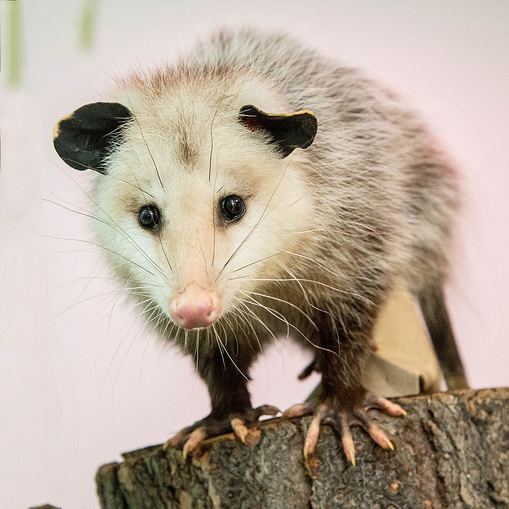 | ||
Length 35 – 94 cm (Adult, Without Tail) Mass Male: 0.8 – 6.4 kg (Adult), Female: 0.3 – 3.7 kg (Adult) Similar Opossum, Large american opossums, Mammal, Marsupial, Common opossum | ||
Orson the virginia opossum eats his dinner
The Virginia opossum (Didelphis virginiana), commonly known as the North American opossum, is the only marsupial found in North America north of Mexico. In the United States, it is typically referred to simply as a possum. It is a solitary and nocturnal animal about the size of a domestic cat. It is a successful opportunist. It is familiar to many North Americans as it is often seen near towns, rummaging through garbage cans, or as roadkill.
Contents
- Orson the virginia opossum eats his dinner
- Virginia opossum hd mini documentary
- Name
- Range
- Description
- Tracks
- Behavior
- Reproduction
- Life span
- Relationship with humans
- References
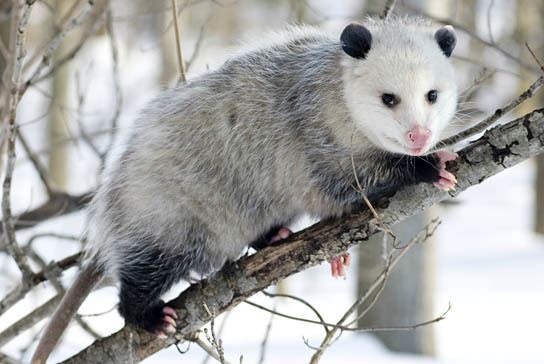
Virginia opossum hd mini documentary
Name
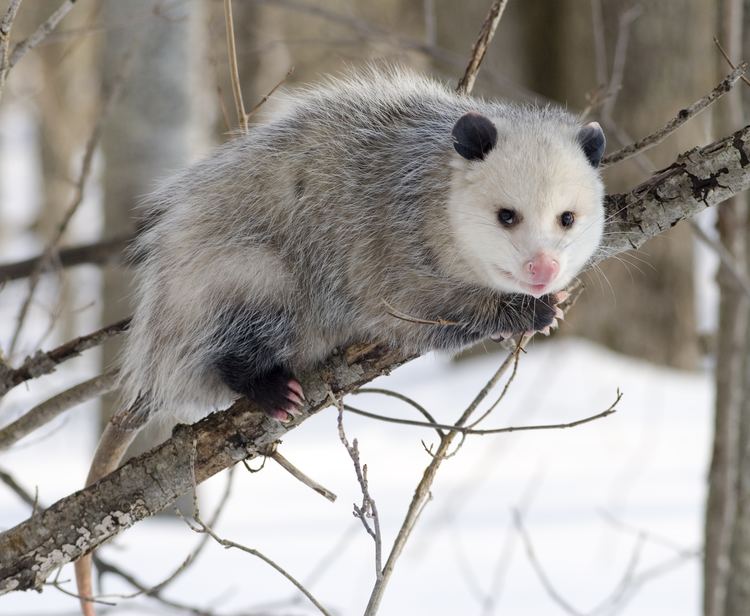
The Virginia opossum is the original animal named "opossum". The word comes from Algonquian wapathemwa meaning "white animal". Colloquially, the Virginia opossum is frequently called simply "possum". The name is applied more generally to any of the other marsupials of the Didelphimorphia and order Paucituberculatas, which includes a number of opossum species in South America.
The generic name (Didelphis) is derived from Ancient Greek: di, "two", and delphus, "womb".
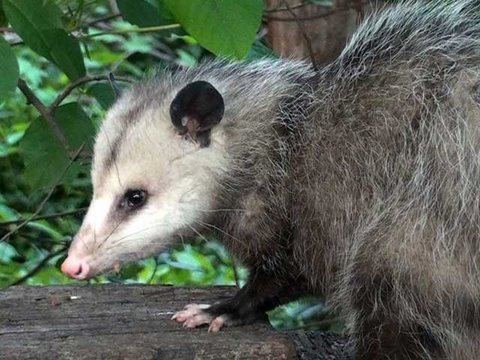
The possums of Australia, whose name is derived from a similarity to the Virginia opossum, are also marsupials, but of the order Diprotodontia.
The Virginia opossum is known in Mexico as tlacuache, tacuachi, and tlacuachi, from the Nahuatl word tlacuatzin.
Range
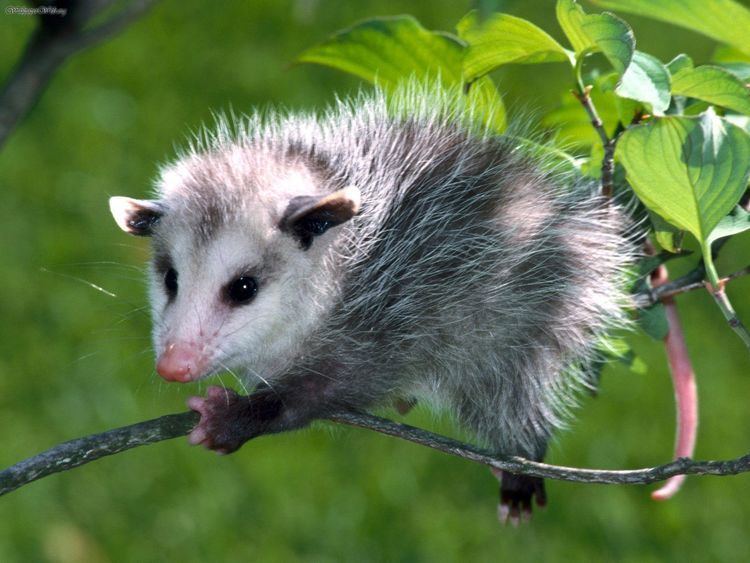
The Virginia opossum is found throughout Central America and North America east of the Rockies from Costa Rica to southern Ontario; it seems to be still expanding its range northward and has been found farther north than Toronto. In recent years, its range has expanded west and north as far as northern Minnesota. Its ancestors evolved in South America, but invaded North America in the Great American Interchange, after the formation of the Isthmus of Panama about 3 million years ago.
The Virginia opossum was not originally native to the Western United States. It was intentionally introduced into the West during the Great Depression, probably as a source of food, and now occupies much of the Pacific coast. Its range has been expanding steadily northward into Canada.
Description
Virginia opossums can vary considerably in size, with larger specimens found to the north of the opossum's range and smaller specimens in the tropics. They measure 13–37 in (35–94 cm) long from their snout to the base of the tail, with the tail adding another 8.5–19 in (21.6–47 cm). Weight for males ranges from 1.7 to 14 lb (0.8–6.4 kg) and for females from 11 ounces to 8.2 lb (0.3–3.7 kg). They are one of the world's most variably sized mammals, since a large male from northern North America weighs about 20 times as much as a small female from the tropics. Their coats are a dull grayish brown, other than on their faces, which are white. Opossums have long, hairless, prehensile tails, which can be used to grab branches and carry small objects. They also have hairless ears and a long, flat nose. Opossums have 50 teeth, more than any other North American land mammal, and opposable, clawless thumbs on their rear limbs.
Opossums have 13 nipples, arranged in a circle of 12 with one in the middle.
Perhaps surprisingly for such a widespread and successful species, the Virginia opossum has one of the lowest encephalization quotients of any marsupial. Its brain is one-fifth the size of a raccoon's.
Tracks
Virginia opossum tracks generally show five finger-like toes in both the fore and hind prints. The hind tracks are unusual and distinctive due to the opossum's opposable thumb, which generally prints at an angle of 90° or greater to the other fingers (sometimes near 180°). Individual adult tracks generally measure 1.9 in long by 2.0 in wide (4.8 × 5.1 cm) for the fore prints and 2.5 in long by 2.3 in wide (6.4 × 5.7 cm) for the hind prints. Opossums have claws on all fingers fore and hind except on the two thumbs (in the photograph, claw marks show as small holes just beyond the tip of each finger); these generally show in the tracks. In a soft medium, such as the mud in this photograph, the foot pads clearly show (these are the deep, darker areas where the fingers and toes meet the rest of the hand or foot, which have been filled with plant debris by wind due to the advanced age of the tracks).
The tracks in the photograph were made while the opossum was walking with its typical pacing gait. The four aligned toes on the hind print show the approximate direction of travel.
In a pacing gait, the limbs on one side of the body are moved simultaneously, just prior to moving both limbs on the other side of the body. This is illustrated in the pacing diagram, which explains why the left-fore and right-hind tracks are generally found together (and vice versa). However, if the opossum were not walking (but running, for example), the prints would fall in a different pattern. Other animals that generally employ a pacing gait are raccoons, bears, skunks, badgers, woodchucks, porcupines, and beavers.
When pacing, the opossum's 'stride' generally measures from 7 to 10 in, or 18 to 25 cm (in the pacing diagram the stride is 8.5 in, where one grid square is equal to 1 in2). To determine the stride of a pacing gait, measure from the tip (just beyond the fingers or toes in the direction of travel, disregarding claw marks) of one set of fore/hind tracks to the tip of the next set. By taking careful stride and track-size measurements, one can usually determine what species of animal created a set of tracks, even when individual track details are vague or obscured.
Behavior
The Virginia opossum is noted for reacting to threats by feigning death. This is the genesis of the term "playing possum", which means pretending to be dead or injured with intent to deceive. In the case of the opossum, the reaction seems to be involuntary, and to be triggered by extreme fear. It should not be taken as an indication of docility, for under serious threat, an opossum will respond ferociously, hissing, screeching, and showing its teeth, but with enough stimulation, the opossum will enter a near coma. It lies on its side, mouth and eyes open, tongue hanging out, emitting a green fluid from its anus whose putrid odor repels predators. Heart rate drops by half, and breathing rate is slowed by about 30%. Brain activity is unaltered however, and the animal remains fully conscious. Death feigning normally stops when the threat withdraws, and it can last up to six hours. Besides discouraging animals that eat live prey, playing possum also convinces some large animals that the opossum is no threat to their young.
Opossums are omnivorous and eat a wide range of plants and animals such as fruits, grains, insects, snails, earthworms, carrion, snakes, mice, and other small animals. The Virginia opossum has been found to be very resistant to snake venom. Persimmons are one of the opossum's favorite foods during the autumn. Opossums in captivity are known to engage in cannibalism, though this is probably uncommon in the wild. Placing an injured opossum in a confined space with its healthy counterparts is inadvisable.
The Virginia opossum does not hibernate, although it may remain sheltered during cold spells.
Reproduction
The breeding season for the Virginia opossum can begin as early as December and continue through October with most young born between February and June. A female opossum may have one to three litters per year. During the mating season, the male attracts the female by making clicking sounds with his mouth. Like all female marsupials, the females reproductive system is bifid: with two lateral vaginae, uteri, and ovaries, and the small (comparable to a dime at birth) young are delivered through a birth canal known as the median vagina that forms shortly before birth. The male's penis is also bifid, with two heads, and as is common in American marsupials, the sperm pair up in the testes and only separate as they come close to the egg. It is common for 20 or 30 young to be born (and even as many as 50), but the female only has 13 teats, arranged in a circle with one in the center, so only the first 13 may survive. An average litter is eight or nine joeys, which will reside in their mother's pouch for about two-and-a-half months, before eventually climbing on her back. They leave their mother after about four or five months.
Life span
Opossums, like most marsupials, have unusually short lifespans for their size and metabolic rate. The Virginia opossum has a maximal lifespan in the wild of only about two years. Even in captivity, opossums live only about four years. The rapid senescence of opossums is thought to reflect the fact that they have few defenses against predators; given that they would have little prospect of living very long regardless, they are not under selective pressure to develop biochemical mechanisms to enable a long lifespan. In support of this hypothesis, one population on Sapelo Island, 5 miles (8 km) off the coast of Georgia, which has been isolated for thousands of years without natural predators, was found by Dr. Steven Austad to have evolved lifespans up to 50% longer than those of mainland populations.
Relationship with humans
Like raccoons, opossums can be found in urban environments, where they eat pet food, rotten fruit, and human garbage. Though sometimes mistakenly considered to be rats, opossums are not closely related to rodents, or other placentalian mammals. They rarely transmit diseases to humans, and are surprisingly resistant to rabies, mainly because they have lower body temperatures than most placental mammals. In addition, opossums limit the spread of Lyme disease, as they successfully kill off most disease-carrying ticks that feed on them.
The opossum was once a favorite game animal in the United States, in particular in the southern regions which have a large body of recipes and folklore relating to it. Their past wide consumption in regions where present is evidenced by recipes available online and in books such as older editions of The Joy of Cooking. A traditional method of preparation is baking, sometimes in a pie or pastry, though at present "possum pie" most often refers to a sweet confection containing no meat of any kind.
Although it is found throughout the country, the Virginia opossum's appearance in folklore and popularity as a food item has tied it closely to the American Southeast. In animation, it is often used to depict uncivilized characters or "hillbillies". The title character in Walt Kelly's long-running comic strip Pogo was an opossum. In an attempt to create another icon like the teddy bear, President William Howard Taft was tied to the character Billy Possum. The character did not do well, as public perception of the opossum led to its downfall. In December 2010, a cross-eyed Virginia opossum in Germany's Leipzig Zoo named Heidi became an international celebrity. She appeared on a TV talk show to predict the 2011 Oscar winners, similar to the World Cup predictions made previously by Paul the Octopus, also in Germany.
